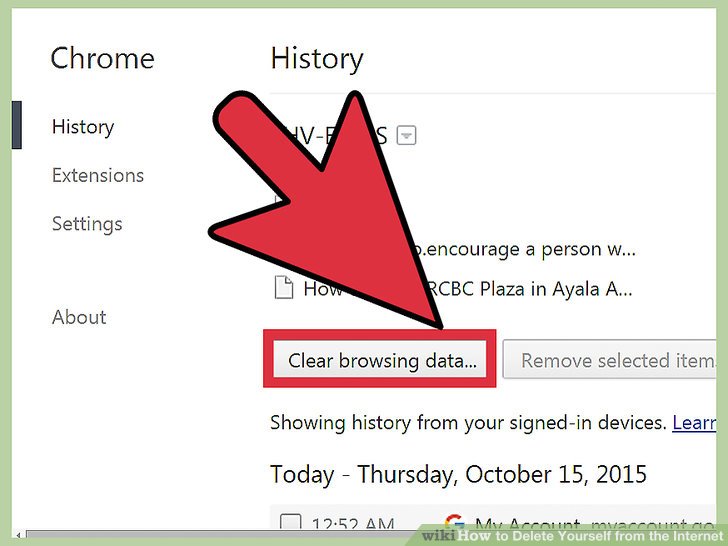Go Delete Yourself From The Internet: A Practical Guide

Table of Contents
Understanding Your Digital Footprint
Your digital footprint encompasses all the information about you available online. This includes everything from your social media profiles and online shopping history to comments on forums and even data breaches that expose your personal information. An extensive online presence can have significant long-term consequences, impacting everything from job opportunities to your personal safety.
Consider these implications of a large digital footprint:
- Reputational Damage: Negative online content can severely damage your reputation, making it difficult to find employment or secure loans.
- Identity Theft: Your personal data can be exploited for identity theft, leading to financial and legal problems.
- Targeted Advertising: Extensive online tracking enables targeted advertising, often leading to intrusive and unwanted solicitations.
- Privacy Violations: Your personal information could be misused or sold without your consent.
Here are some key components of your digital footprint:
- Social media profiles: Facebook, Instagram, Twitter, and other platforms store vast amounts of your personal information.
- Online forums and comments: Your contributions to online discussions leave a lasting digital trace.
- Search engine results: A simple Google search can reveal a surprising amount of information about you.
- Online shopping history: Websites track your purchases, creating a detailed profile of your spending habits.
- Data breaches and leaks: Security breaches can expose sensitive personal information, impacting your privacy for years.
Locating Your Online Information
Before you can delete your online information, you need to know where it is. This requires a thorough search using various techniques and tools.
Here’s how to perform a comprehensive search for your personal information:
- Using Google Search with advanced operators: Utilize advanced search operators like
site:,inurl:, andintitle:to refine your search and uncover hidden information. For example,site:facebook.com "your name"will search for your name only on Facebook. - Exploring social media platforms and reviewing past activity: Thoroughly check your profiles and activity on all social media platforms, reviewing old posts, comments, and shared information.
- Using specialized search engines: Services like Pipl and WhitePages specialize in aggregating personal information from various sources. Use these tools cautiously and be aware of their privacy implications.
- Checking online archives: The Wayback Machine archives website snapshots over time, potentially revealing information you thought was deleted.
Removing Your Information From Search Engines
Once you’ve located unwanted information, you can try to get it removed from search engine results. This process is often challenging, but it's possible to have some information removed, depending on Google's policies.
- Understanding Google's removal policy: Google's policy focuses primarily on removing outdated or inaccurate personal information, such as outdated contact details or content relating to identity theft.
- Preparing a removal request: Google provides a removal request tool; you’ll need to provide evidence supporting your claim.
- Submitting the removal request and monitoring its status: Submit your request and keep track of its progress. It can take time for requests to be processed.
- Alternative strategies for mitigating unwanted search results: If removal isn't possible, consider creating positive content that pushes down negative results in search rankings. This involves producing your own content around your name that will ideally appear higher in search results.
Deleting Your Accounts and Data
Deleting your accounts is a crucial step in minimizing your online presence. This process varies across different platforms. Remember to always download your personal data before deletion, if the platform allows it.
- Step-by-step instructions for deleting accounts on common platforms: Each platform (Facebook, Twitter, Instagram, etc.) has a specific procedure for account deletion; refer to their help sections.
- Best practices for securely deleting files and data from personal devices: Use secure deletion software to completely erase files from your hard drive, preventing data recovery.
- Understanding data retention policies of different platforms: Be aware that some platforms retain data even after account deletion for legal or technical reasons.
Protecting Your Future Online Privacy
Minimizing your future digital footprint requires proactive measures and mindful online habits. These best practices should become second nature:
- Using strong, unique passwords: Employ strong, unique passwords for all your online accounts. Use a password manager to help you manage them.
- Enabling two-factor authentication: Add an extra layer of security to your accounts with two-factor authentication.
- Using privacy-focused browsers and search engines: Consider using privacy-focused browsers like Brave or Firefox with enhanced privacy settings.
- Being mindful of what information is shared online: Think twice before posting personal information online. Be aware of the potential consequences.
Conclusion
Going delete yourself from the internet is a multi-step process that requires patience and persistence. By understanding your digital footprint, locating your online information, removing it from search engines, deleting accounts and data, and practicing safe online habits, you can significantly reduce your online presence and protect your privacy. Start reclaiming your online privacy today by taking the first steps to "go delete yourself from the internet." This guide provides a solid foundation, but remember that proactive privacy management is an ongoing process. Use the techniques outlined above to minimize your digital footprint and build a safer online experience.

Featured Posts
-
 Jelentos Forgalmi Akadalyok Az M3 Ason Heti Elorejelzes
Apr 23, 2025
Jelentos Forgalmi Akadalyok Az M3 Ason Heti Elorejelzes
Apr 23, 2025 -
 Complete 2025 Us Holiday Calendar Federal And Non Federal Holidays
Apr 23, 2025
Complete 2025 Us Holiday Calendar Federal And Non Federal Holidays
Apr 23, 2025 -
 Analyzing The Brewers Batting Order Changes Impact And Effectiveness
Apr 23, 2025
Analyzing The Brewers Batting Order Changes Impact And Effectiveness
Apr 23, 2025 -
 Dodgers Roberts Admits Key Hit Altered World Series Outcome
Apr 23, 2025
Dodgers Roberts Admits Key Hit Altered World Series Outcome
Apr 23, 2025 -
 Jan 6th Committee Witness Cassidy Hutchinson To Publish Memoir
Apr 23, 2025
Jan 6th Committee Witness Cassidy Hutchinson To Publish Memoir
Apr 23, 2025
